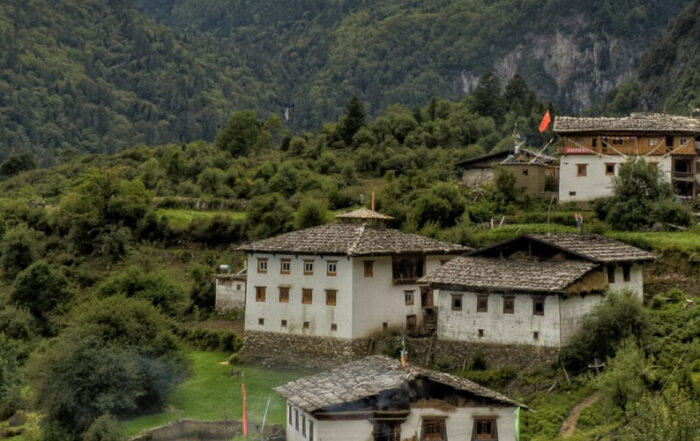The Vedas are the earliest known works of spiritual literature on the planet. These and other great scriptures, for instance, Mahabharata and Ramayana, contain the stories of the Saptarishi, or seven great sages.
These sages are the sons of the mighty Brahma. He sent them to earth, thus supporting the spiritual evolution of humanity and the unfolding of the entire universe.
The Vedic Maharishi’s and the Unfolding of the Universe
According to various texts that outline what we can loosely term ‘Hindu’ or Vedic cosmology, this universe unfolds in enormous, lengthy cycles of time. A cycle of the universe is named Manvantara which subsequently break down into four shorter cycles of time named Yugas.
During each Manvantara (apparently we are currently traversing the 7th Manvantara), there are a number of divinely born Rishis. Importantly, these sages are appointed by Brahma the creator to guide the unfolding of the universe.
These Rishis are known variously as Maharishis, Saptarishi, Brahmarishi, Mahasiddhas, Rajarishi etc. are considered to be fully awakened. As such, these divine incarnations possess a fully developed capacity for perception that encompasses the entirety of space and time.
They are mysterious and auspicious beings whose support is always available.
The Contributions of the Saptarishi
The contributions of these maharishis to the spiritual wealth of humanity is enormous. To them are attributed many of the ancient sciences. Above all, perhaps is the composition of the Vedas. Also, the developed: Yoga, Ayurveda (Indian medicine), Siddha medicine, Jyotish (Vedic Astrology), various languages, and of course many other spiritual texts. Including the Upanishads, the Puranas and the Hindu epics such as Mahabharata.
These great divine being were appointed by Brahma to carry out this role of spiritual preceptors of the universe. Yet their divine status was not given entirely freely. Each in their own way performed severe penance and austerity to rise to the rank of Brahmarishi (one who has complete knowledge or identity with Brahman).
For instance, In the case of Vishvamitra, Brahma did recognize his status as a Brahmarishi. But only after thousands of years of intensive austerity and spiritual practice in the Himalaya.

Who Are the Saptarishi?
The term saptarishi means seven rishis (sages or seers). However, as in common to this period in Indian history, the list of exactly which seven rishis actually constitute the saptarishi varies.
Actually, the Vedic literature that refers to the saptarishi never lists them by name.
However, the earliest list of the Seven Rishis is given in the text Jaiminiya Brahmana in verses 2.218–221 as: Agastya, Atri, Bhardwaja, Gautam, Jamadagni, Vashistha and Vishvamitra.
A list also appears in Brihadaranyaka Upanishad: Atri, Bharadwaja, Gautama, Jamadagni, Kashyapa, Vashistha and Vishwamitra.
But Gopatha Brahmana names Vashistha, Vishvamitra, Jamadagni, Gautama, Bharadvaja, Gungu, Agastya and Kashyapa as the seven rishis.
Further, to confuse matters even more, it was not uncommon in those days for a single spiritual figure or master to be known by different names depending on the region.
According to Sadguru, 15,000 years ago Adiyogi, or shiva, appeared in the himalaya. He was blue and over 9 feet tall. He sometimes would sit for incredible periods in perfectly immobile meditation. In other moments he would dance wildly.
Many were amazed by this matted haired yogi. Many gathered to receive teachings. But Adi yogi sat for so long absorbed in meditation that gradually they lost interest. Eventually only 7 remained. Those 7 were given simple practices to prepare them to receive the teachings of shiva.
Finally, after many years, those beings had become shining examples of what humanity could be. And they were ready to receive the teachings of Adiyogi, the first yogi, originator of the entire science of yoga.
Saptarishi in Astronomy
In ancient Indian astronomy, the constellation of the Big Dipper {Ursa Major} is called saptarishi, with the seven stars representing seven rishis, namely “Vashistha”, “Marichi”, “Pulastya”, “Pulaha”, “Atri”, “Angiras” and “Kratu”. There is another star slightly visible within it, known as “Arundhati”. Arundhati is the wife of Sage Vashistha.
Sri Agastya Maharishi
Beloved author of many of the palm leaf prophecies, we discussed Agastya maharishi length in a previous blog post.
Agastya, as with many of the other saptarishi, is credited as having contributed hymns to the rig veda. He is also a pioneer of Indian medicine, a master martial artist and a pioneer of Tamil grammar.
Sri Atri Maharishi
Atri is the saptarishi most mentioned in the Rig Veda. 87 of the hymns were composed by him and the fifth book of Rig Veda is named after him.
Atri Maharishi is the son born of the mind of Brahma. He impressed the trinity of Shiva, Brahma and Vishnu with his penance and was rewarded by the three with the granting of boons. Thus he chose to father 3 children, one incarnation of each. Those 3 sons were Dattatreya, Durvasas and Soma. Respectively, incarnations of Brahma, Vishnu and Shiva.
There are 4 major works attributed to Maharishi Atri. Purvatantra, Atreyatantra, Vishnutantra and Uttaratantra. Other texts also mention him in various roles including, importantly, as preceptor in the dissemination of the system of Ayurveda.
This is a fundamental understanding that underlies the entire tantric path to liberation. The world, or appearance, is not as it seems. This does not make it bad, wrong, or even problematic. In fact it makes it even more special, sacred, beautiful as rich, fertile ground for living Sadhana (spiritual practice).
A story from the Mahabharata of Saptarishi Atri
A story from the Mahabharata reconuts Atri’s council to Dronacharya on the battlefield. His guidance not only stopped the war, but inspired Dronacharya to engage in meditation, which he did willingly in the midst of battle. Subsequently, Dronacharya remained in constant meditation from that point until leaving his body.
“Dear friend, all along you have done everything against Dharma. This war you are engaged in is the best proof. It is enough and stop it. Stop this carnage. You are a good man. This act is not in tune with your status.
You are a scholar of Vedanta par excellence. You have been a Brahman and you have to practise dharma. This cruel act does not befit you. Give up your weapons, fix your mind in our glorious Sanathana Dharma. I am sorry, you have wielded the most terrible Brahmastra on the innocent soldiers! Put an end to your meaningless killing.”
Vatavarana Shastra, a text written by Atri, addresses types of clouds. It categorizes 12 kinds of rain, 64 types of lightning, 33 varieties of thunderbolts, etc. The Bhrigu, Atri and Marichi Samhitas go into different aspects of architecture of Vaikhanasa Vishnu temples, while other fragments cover Chitra karma or painting of pictures of deities.
Saptarishi Bhardwaja
Bhardwaja or Bharadvaja, is also mentioned many times in the Rig Veda. The entire sixth chapter is attributed to him and his disciples. He is the son of Brihaspathi (Jupiter). His contributions to the world, especially as a scholar and also as an economist, grammarian and physician are well noted in the Mahabharata and Ramayana.
Various other texts reference his contributions to the art of archery, Sanskrit language and Ayurvedic medicine.
He is the father of Dronacharya. There are differing legends around the birth of Dronacharya. One states that he was born of a brief affair with an apsara. The other common legend from the Mahabharata states that Dronacharya was born when Bhardwaja ejaculated into a clay pot.
Due to his marriage to a Kshatriya (warrior caste) woman named Suseela, it is said that all of his descendents possessed both scholarly and warrior attributes and skill.
A story from the life of Maharishi Bhardwaja
This story suggests his renown as a master capable of producing miracles.
He once invited Lord Indra, Lord Agni and Lord Soma to a feast organised for a Yagya. Much to the dismay of the sage and his wife, a demon appeared out of the first made for preparing the food and devoured the entire meal.
Through loving inquiry, the sage discovered that this demon was given permission by Lord Brahma to ruin every Yagya performed anywhere on earth. Due to sage Bhardwaja’s kindness, the demon told the sage that this condition was not his original form, that he was actually cursed by Brahma. Subsequently the demon requested the sage to help lift the curse.
After performing Abhishekam with water from the Ganga, gold and ghee, the sages kindness released the demon from the curse. At the sages request the demon then blessed the Yagya.
Sri Gautama
Maharishi Gautama features largely in the Ramayana. He is known for cursing his wife after she made love to the God Indra.
The story says that one day Gautama Rishi went to bathe in the Ganga. While he was away, the God Indra took the disguise of Gautam and went to visit his wife. Then they made love and Indra left. However the real Gautam caught Indra escaping as he returned.
He cursed both Indra and his wife, turning the latter to stone. As a result of making such terrible curses, the power that allowed him to do so, earned through 60 years of penance, was taken away from him.
Gautama Maharishi was known to have mastered the Gayatri Mantra and was one of very few beings said to have understood its full depth and significance. He was even know as Mantra-drashta due to the number of mantras and hymns he composed.
Jamadagni
O Jamadagni! The resplendent one. You gleam verily like fire because of your austerities. To uphold the righteousness in all the worlds, do quell my sins.
O Jamadagni! You alone can uphold righteousness in the world by your effulgent third eye that you had attained by your strict penance!
The Great sage Jamadagni was renowned for his Sattvic qualities. Infact, according to legends, his father once made a kind of potion and gave it to a woman named Satyavatī. The idea was that she would give birth to a child who possessed only the sattvic qualities of a Brāhmaṇa.
However, even with such a sattvic disposition, there was one occasion where the sage was overcome with anger.
Once his wife Reṇukā was fetching water when she was overcome with desire for a Gandharva that she saw in a chariot in the sky.
When Jamadagni learned of this transgression through a spiritual vision, he flew into a rage. He ordered his sons to kill Reṇukā for her actions. All but one son Paraśurāma refused to carry out such a heinous act. Subsequently, Paraśurāma killed his mother and his brothers.
Jamadagni was pleased and offered to grant his son anything he desired. Paraśurāma requested that his mother and brothers be brought back to life. Moved by the love of his son for his wife and other sons, Jamadagni immediately granted the wish.
Saptarishi Vashistha
Revered Maharishi Vashistha is credited as the author of the 7th chapter of Rig Veda. He is mentioned extensively in Vedic literature.
The Yoga Vashistha is arguably his most important contribution. This massively influential text presents the philosophies of Yoga and Vedanta side by side. Indeed, the great teacher of Vedanta, Adi Shankaracharya referred to Vashitha as the first teacher of Vedanta.
In the form of the frustration, path, and liberation of Rama, this text presents the basic existential struggle of humanity. Using stories to conceal complex philosophy and cosmology, the Yoga Vashishtha presents an in depth outline of the journey from confusion and turmoil of the human condition to the complete freedom experienced by liberated beings.
A well known story that made both Vashistha and Vishvamitra famous tells of the time that Vishvamitra, then a king, went to war with Vashitha because he coveted a sacred cow named Nandi. It is said that this cow could grant and material desires.
Out of possession of greed, Vishvamitra went to war with Vashistha. The great sage defeated the jealous king. Vishvamitra then entered into a long period of penance in order to acquire the power to overcome Vashistha. He was successful in his penance and acquired many powers, yet was still unable to defeat his foe.
Later Vishvamitra himself became a Brahmarishi.
Vishvamitra
Rajarishi Vishvamitra is considered the author of most of the 3rd book or mandala of the Rig Veda. The title Rajarishi specifically refers to a king who became enlightened through penance and devoted spiritual practice.
Vishvamitra discovered the Gayatri Mantra. He is considered the first of only 24 sages who could fully comprehend its meaning.
ॐ भूर्भुवः स्वः तत्सवितुर्वरेण्यम भर्गो देवस्य धीमहि।
धियो यो नः प्रचोदयात॥
Aum Bhur Bhuvah Svah Tat Savitur Varenyam Bhargo Devasya Dheemahi
Dhiyo Yo Nah Prachodayat
There are many translations of this mantra into English, here are a few examples.
“Let us meditate on Isvara and His Glory who has created the Universe, who is fit to be worshipped, who is the remover of all sins and ignorance. May he enlighten our intellect.”
-Swami Shivananda
“We meditate on the glory of that Being who has produced this universe; may She enlighten our minds.”
-Swami Vivekananda
“Oh manifest and unmanifest, wave and ray of breath, red lotus of insight, transfix us from eye to navel to throat, under canopy of stars spring from soil in an unbroken arc of light that we might immerse ourselves until lit from within like the sun itself.”
-Ravi Shankur
There are many examples from the life of Vishvamitra that elucidate the challenges and difficulty that he went through for thousands of years before both the sage Vasistha and Lord Brahma themselves appeared before the sage and conferred upon him the title of Brahmarishi.

About My Palm Leaf
The legends say that thousands of years ago, a group of Indian sages perceived the lives of people living throughout all ages and wrote them onto the Palm Leaves. These manuscripts are stored in temple libraries all over the south of India.
We help you to find your manuscript, have a reading online and receive the guidance of the sages. This guidance can assist you to overcome obstacles in your life, and understand your life from a higher perspective.


